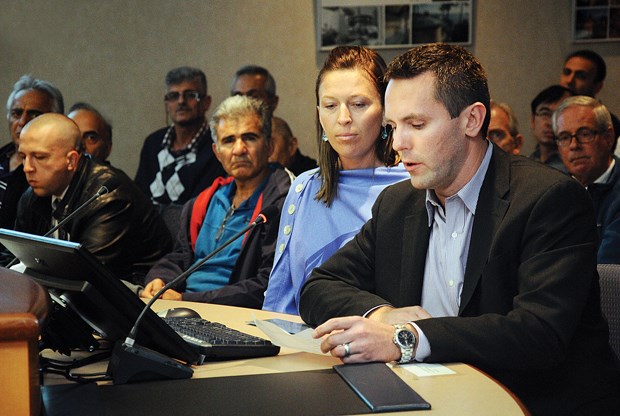If West Vancouver enacts any reduction to maximum allowable square footage in single-family homes, it will be over the staunch opposition of the district's builders and developers.
Council moved unanimously to commence community consultation and draft a bylaw that would address form and character in West Vancouver homes. The bylaw is tentatively scheduled to return to council for consideration in early 2015.
A boisterous crowd packed council chambers Monday, many of them concerned new regulations would strip freedoms from homeowners and cause the district's real estate market to plummet.
The real estate market will drop this year, according to Mulberry Property Group director Sam Whiffin.
"Values will come down, and they won't wait for next year to come down," he warned.
Large homes are in demand because families need them, according to Whiffin.
"Generally, both parents work, they do have staff, they have large families," he said. "If you want smaller houses, it's not going to be as attractive for affluent people to live here."
Council never intended to damage property values, assured Mayor Michael Smith.
"Obviously we're all homeowners ourselves, so that wouldn't be very smart," he said.
While the vast majority of builders do fine work, there is a need for new rules to protect the special flavour of the district, according to Smith.
"We do have some builders that really don't give a fig about the neighbourhood and act as if this was Newton instead of West Vancouver," he said.
Council needs to act swiftly to remedy a problem that has been decades in the making, according to Coun. Trish Panz.
"We hear this constantly in this community, that we are losing the character of our neighbourhoods," she said.
The issue is complicated by West Vancouver's topographical diversity, according to Coun. Mary-Ann Booth.
Booth suggested encouraging building basements in a bid to lower overall heights.
Several speakers, including real estate agent Marc Burrows, expressed concern that council was guided by nostalgia.
"West Vancouver's no longer a fishing village," he said. "Longtime residents are so desperate to preserve the social and domestic setting of 30 years ago, but those goals are deterring the next generation from investing here."
Burrows cited several architects, including Arthur Erickson, who built homes that were "drastically bigger" than was customary.
The discomfort of one family shouldn't trigger the revision of the building policy, Burrows said, referring to David and Amber Trent, of Kensington Crescent.
The Caulfeild couple recently garnered headlines after filing a lawsuit over the safety hazards and constant disruption posed by the construction of a 17,500-square-foot-home next door.
Trent urged council to examine housing bulk, tree retention, and safety.
"Since June we've been in tears at the destruction of our neighbourhood," he said.
Trent showed slides illustrating an imposing rubble pile and lost trees.
"Every surrounding municipality has some sort of bylaw on trees on private property. We have nothing," he said.
Trent also spoke about the erosion of a community that was once filled with neighbours who looked out for one another.
Monster homes are a perpetual problem in West Vancouver with excavators constantly blasting, according to Sander Heynemans. "Up until a few years ago, all was well, until the big money discovered our neighbourhood and brought with them a truck full of dynamite."
Heynemans took exception to comments from several speakers.
"I'm getting to think that the real estate industry is unionized," he said.
Homeowners should be informed before "neighbourhood-busting designs" break ground, according to Heynemans.
"The real power lies with the mantra that keeps coming from city hall: 'they are in compliance with all the bylaws.' Council and planning must engage the stakeholders in order to reform the bylaws so you don't just function as the complaint department."
The problem will likely not be solved with a district-wide bylaw, according to councilwatcher Carolanne Reynolds, who suggested distinct guidelines
governing bulk and form be drawn up for each of the district's distinct communities.
"We all know one size doesn't fit all," she said. "We can all get along but we shouldn't force one side on the other."
The district's official community plan ensures new homes will be sympathetic with neighbourhood character, but that hasn't been happening, according to Coun. Nora Gambioli. "We are not following our own OCP," she said.
Many speakers were brought to the meeting by what Gambioli called a "cowardly and shameful" flyer that incorrectly stated council would reduce the square footage of homes in Ambleside and Dundarave. However, the flyer does have an upside, she added.
"It has caused the benefit of engaging a lot of you, 95 per cent of whom I don't recognize and have never seen here in council chambers, so that seems like a good start."



